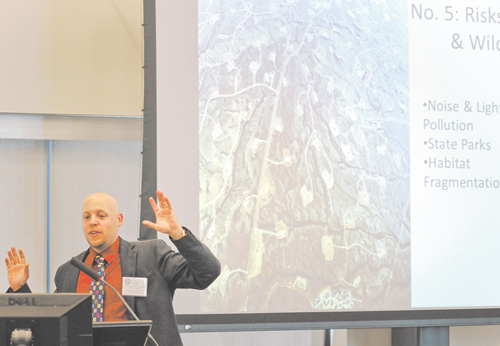

Friday, September 28, 2012

Trent Dougherty, chief legal analyst for the Ohio Environmental Council, stands before a group of journalists Thursday to explain the complexities of the oil and gas industry.
YOUNGSTOWN
Seldom do journalists cover an event geared toward themselves, especially as it relates to the oil and gas industry.
Across the state, reporters spend their days poring through a trove of industry information and deciding how best to convey the shale-gas boom under way in eastern Ohio in an objective and accurate way.
Sometimes that coverage is skewed and imperfect; at others the story is told the way it should be.
On Thursday at an event put on by the Ohio Newspaper Organization titled “A Journalist’s Guide to Drilling,” reporters had a chance to check themselves and ask the questions they sometimes can’t.
At the Williamson College of Business Administration on the Youngstown State University campus, officials from the Ohio Department of Natural Resources, the Ohio Environmental Council, industry insiders and professors sought to educate journalists on the complexities of an industry that is rapidly unfolding with great implications for Ohio.
“There’s a vast difference of opinion on this issue,” said Trent Dougherty, general counsel and chief legal analyst for the Ohio Environmental Council. “The news is doing a great job covering it all, but there really appears to be no middle ground. I think readers would like to see more solutions and better answers to all the noise.”
Thursday’s event sought to provide Ohio’s journalists with a better working knowledge of an industry that involves 75 different professions, explores and drills for oil and gas across the Utica Shale play, which is larger than Saudia Arabia; and encompasses a host of different sciences and technologies.
According to Rhonda Reda, executive director of the Ohio Oil and Gas Energy Education Program, it will become increasingly important for journalists to get better educated.
By 2015, her organization estimates that Ohio’s natural gas and crude oil industry, through its own expenditures, could generate $12.3 billion in gross state product and have a statewide output or sales of $23 billion.
What’s more, the industry in Ohio alone could distribute $1.6 billion in royalty payments to local landowners, schools, businesses and communities based on an estimate of 2,837 new Utica wells by 2015. This would exceed the total amount of national royalties paid for all geological formations between 2000 and 2010.
“This is just the beginning,” Reda said. “Right now all you’re seeing is the leasing and exploration stage. Not only will that leasing activity ramp up, but real production won’t even get going until 2014 and 2015.”
After 2015, some wells could produce for between 20 and 40 years.
Equally important, Dougherty said, is keeping an eye on all the issues from legislative efforts and environmental grievances, to success stories, compliance enforcement on the ground and policy matters.
Journalists in Ohio, Thursday’s speakers said, should be especially well-versed in the topic. It was here, in 1814, that the U.S. first discovered crude oil at a location along Duck Creek in Noble County. Hydraulic fracturing also was pioneered in the state beginning in 1941.
“I get reporters calling me all the time asking me to explain something in five minutes that takes years to learn,” said Gene Chini, north region district supervisor for the Division of Oil and Gas Resources Management at ODNR. “You can hear them frantically scribbling it all down in the background — that’s not accurate. They need to do their research in order to inform the public properly.”